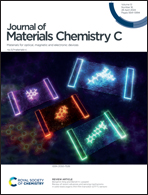Enhancement of the charge-generation efficiency for a naphthalene diimide-based polymer semiconductor by using a pyrene-substituted n-dopant†
Abstract
Efficient n-type doping remains a significant challenge in the field of organic thermoelectric materials, despite the documentation of several n-dopants. In this work, a new solution-processable n-type dopant (Py-DMBI) featuring a pyrene unit was synthesized and investigated, with the intention to improve the miscibility of the dopant and naphthalenediimide (NDI)-based conjugated polymer by utilization of the specific interaction between pyrene and the naphthalene diimide units. The results reveal that Py-DMBI shows improved charge-generation efficiency (i.e. the ratio of the number of generated charge carriers to the number of dopant molecules) toward the NDI based conjugated copolymer (PNDI2TEG-2Tz) in comparison with 4-((1,3-dimethyl-2,3-dihydro-1H-benzoimidazol-2-yl)phenyl)dimethyl-amine (N-DMBI), which is a widely used n-dopant. The Py-DMBI doped PNDI2TEG-2Tz exhibits a maximum power factor of 15.7 μW m−1 K−2 with a conductivity and Seebeck coefficient of up to 3.5 S cm−1 and −211 μV K−1, respectively.



 Please wait while we load your content...
Please wait while we load your content...